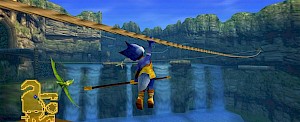Column: Polygon Shotgun #2

Posted 03 Aug 2008 at 08:48 by Ashley Jones

Written by Maikel de Bakker
Edited by Ashley Boyd
Maikel de Bakker questions why videogames are often not regarded as 'art', and whether or not they should be.
| "Art in it’s purest for; one-hundred percent imagination." |
People talk about art and music as cultural legacy, but do they ever think that we also have a new cultural legacy? Sure we all know the artists Van Gogh and Leonardo da Vinci, and we all know who Bach, Mozart and Queen were. Even if we talk about Steven Spielberg and Walt Disney everyone knows whom we are talking about, but as soon we start talking about video games, no one knows.
Only few know that gaming history was written in 1958 when William A. Higinbotham, the creator of Tennis for Two, began his project in the Brookhaven National Laboratory. His idea was to use a small analogue computer in the lab to track and display the trajectory of a moving ball on an oscilloscope, with which users could interact. Missile trajectory plotting was one of the specialities of computers at the time, the other being cryptography. In fact, the first electronic computer was developed to plot the trajectory of the thousands of bombs to be dropped during World War II.

And people complain about the Wii’s graphics.
As head of Brookhaven's Instrumentation Division, and being used to build such complicated electronic devices as radiation detectors, it was no problem for Higinbotham, along with Technical Specialist Robert V. Dvorak who actually assembled the device, to create the game system they named Tennis for Two in three weeks, and it debuted with other exhibits in the Brookhaven gymnasium at the next open house in October 1958. In the rudimentary side-view tennis game, the ball bounces off a long horizontal line at the bottom of the oscilloscope, and there is a small vertical line in the centre to represent the net. Two boxes, each with a dial and a button, are the controllers. The dials affect the angle of the ball trajectory and the buttons "hit" the ball back to the other side of the screen. If the player didn't curve the ball right it crashed into the net. A reset button was also available to make the ball reappear on either side of the screen ready to be sent into play again. No score was tabulated, and it was displayed in glorious phosphor monochrome on a puny 5" oscilloscope screen, but it was still a big hit with everyone who visited the display. There were people who queued in line for hours to play it.
Nowadays, games surprise us in every way. We enjoy the worlds we live in and we love to explore them in every way. Did it ever occur to you that you were walking around in true art? Art in its purest form; one hundred percent imagination. I hope that the next time you walk around a vast world created by our beloved game developers you will stop and look. Just look and I am sure you will see things you did not notice before! This is art! 3D art.

Okami shows how well videogames can be artistic.
For example:
In a world far, far removed from the visuals of our own. A world where you can make stones float in thin air, where trees seem to grow out of the rocks and water has the strange habit of creating the strangest creatures you have ever seen. Three suns rise as two moons fall. Weird creatures roam the sky and even more bizarre creatures walk on dry ground, yet the plants grow and flourish everywhere you look. And the strangest thing of is not anything belonging to this the world, it's that you are acting like it’s perfectly normal.
| ” But what makes art, art? And who says that the art of videogames isn’t art at all? " |
While you see an island rise from the depths of the dark gloomy waters you think; is this where you have to go? Is that the place where the treasure is? And you start looking for a way to cross these dangerous waters. I will tell you a bit more about why we seem to find this as normal as every other thing we know. We have all been playing games for years now; most of us have seen pixels as big as a fifth of our television screens. And we all have seen walking mushrooms and heard talking bombs. While sprites filled our world of gaming we never gave credit to the backgrounds the game had. Now we have arrived in a new time where things are a bit different than, from those fine days when we did not have to wonder how we have to cross the dark gloomy waters like we do now.
As the heroine experiments you may find out that trees don't float in this world, but then our heroine has found a strange white rock the size of a large car. She picks it up and as if it was a paper plane she throws the rock in the strange waters. Yes, very good, now you have found something that floats. I don't want to spoil the fun right now but don’t you need something to propel you? Hehe. Well, while our heroine is running around the dry lands of our strange world in search of a way to propel herself across the dark waters I’ll tell you a bit more about how we have grown to see this as a very normal sight.
As the years went by we witnessed pixels being replaced by polygons (a polygon is a triangular or square shaped object that can be connected to other polygons) that create the 3D worlds of games and films today. This seemed a very natural thing to happen, as we have seen things like that happen in our commercials and animated television shows and movies. We never thought about the complications the game designers now faced. We take for granted that today’s games take longer to be created compared to 2D games.

Same problem, but in 3D it takes longer.
“We even started complaining that a three year production for one game was too long. Too long to wait for. We learnt to accept things as they are, never wondering why. A legacy we all seem to have forgotten”.
Ah, good. I see you found the whipping flowers and the paddle leaves of that big tree! What? You are not telling me that you did not know they have to be mended together? Well, as you can see our heroine is now smoothly paddling her way across the vast dark waters. As most of us know, we cannot take anything for granted in this world; the world that we find a bit strange. She now has to fight off the creatures from beneath these dark waters that are eating her leaf pedals. After some terrifying moments she has barely reached the shore of the newly risen island, water still streaming from the rocks. And there are even stranger-looking plants everywhere. You see our heroine looking fully adapted to this world. Then she wanders around the isle looking for the treasure.
You see games these days which have vast lands full of adventure and action, and we can look behind every tree and EVERY ROCK… hint. Hmm...she doesn’t get it yet... uhm, where was I? Oh, I remember. Well you can look everywhere. We can imagine that this opened up loads of options for our beloved game developers to show off their imagination and show us the way they want to see the game, as if we were living in their dream, living in the creation of our most beloved game developers, forever wondering what they will come up with next. Ah, so you finally looked behind the big blue rock and you found the switch. Good, good. Well, let’s see what happens.
A sudden shock throws our heroine off her feet and to our surprise the island sinks as quickly as it had risen. It must have been the wrong switch. It seems that I am sometimes wrong too. Well, don’t look at me like that, I didn't say that was the right switch, did I?
In all the art galleries all over the world you never see a videogame.
But what makes art, art? And who says that the art of videogames isn’t art at all? Well you will never hear me say that videogames are not works of art, because they absolutely are! The art that features in videogames like Mario, Zelda, Metroid and many others, is more than impressive. As a gamer I want to stand up and let the world know what our legacy is. And this is what I am here for. I want games, and everything that comes with them, to be known as the twenty-first century legacy.
“If art is frozen music, then a videogame is liquid art”.
Games are so diverse, every time you start up a game you will end up in another world, in another time and with other elements. How is that for art? You literally step into the world of its creator's mind.
Videogames.
Videogames are us.
We are the games.
We have a legacy.
Videogames are our legacy!
N-Europe will help you to understand the importance of our legacy!
And we will keep on going until the world understands the importance of our legacy!
Polygon Shotgun Signing off.
- Maikel de Bakker
N-Europe Staff Writer






















